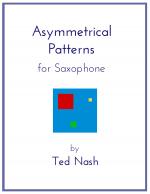ASYMMETRICAL PATTERNS FOR SAXOPHONE
Ted Nash

Cat #: TN-1001
$29.99This item usually ships within 5 to 7 business days.
Questions?
Please call +1-518-587-1102 or email us.
Edition: Paperback Book
Description: 136 Pages
Publisher: TNASH Music
Nature is an incredibly beautiful and diverse thing, and that is largely due to the wonderful variety it expresses. Our world is certainly not perfect in the sense that everything is symmetrical and even. In fact, it's just the opposite: it is beautiful because it is not perfect. The balance that comes from asymmetricality is what creates the natural beauty that we find in so many examples around us: a tree with branches of different sizes and shapes; rivers that wind in different directions; cloud formations which never repeat; the incredibly diverse characteristics of the people around us. The list goes on and on.
Imagine if everything was perfectly symmetrical. It would be artless and boring. In traditional Japanese aesthetics there is a term, wabi-sabi, which is the view or thought of finding beauty in every aspect of imperfection in nature. It is about the aesthetic of things in existence, that are imperfect, impermanent, and incomplete.
Patterns in nature are beautiful as well as important; they help create order. The universe possesses such beauty which is expressed both symmetrically and asymmetrically, and it has been the objective of brilliant scientists for thousands of years to find ways to explain and express the universe using math, geometric shapes and even music. Patterns, like the Fibonacci Sequence, appear naturally in many different expressions, like bird wings and the nautilus shell. While most of us jazz musicians are not trying to explain the meaning of life in our solos, we are trying to express something meaningful. Improvising is the combination of technical ability, knowledge, thought and feeling. The purpose of any thorough practice routine should include developing a technical ability to play what we hear. The concept of developing and playing licks is completely antithetical to what jazz improvisation is all about (although it is natural for a young player to rely on worked-out material until they begin to gain the ability to improvise their own ideas).
Working with patterns can be very useful in developing our technique and keeping our brain sharp. While it's easy to think of patterns as even and balanced, patterns can look and sound completely asymmetrical, depending on the parameters used to create them. And by playing and creating these unusual combinations of notes we can practice not only moving our fingers in ways we hadn't done before but we can challenge our intellect. We also train our ears to hear different combinations of notes. The most important part of improvising is creating ideas, not just running notes. And the purpose of practicing patterns is to train ourselves to develop our technical ability, explore harmony, and develop our ideas.
In this book, I have created over one hundred pages of asymmetrical patterns that will develop your sight-reading and technique, but it will also allow your mind to hear unusual combinations of notes and fresh approaches to uses of scales. Although much of this material is written out, I strongly urge you to continue by making up your own, and certainly to do these in your head, as Mr. Nedzela and I did back stage. This will help develop another important part of improvising and that is idea development - taking an idea and developing it over a period of time and over series of chords. Improvising is more than just a bunch of notes. It is how you choose notes to fulfill ideas. If there are no clear ideas then, ultimately, it just sounds like a bunch of random notes.
In the last section of the book I take the concept of creating patterns and show how we can apply it in different ways over a series of chord changes. In the beginning of each exercise the material is written out. I then ask you to continue using your brain to complete the exercise. This is an extremely valuable step and I implore you to not skip this part of the work.









